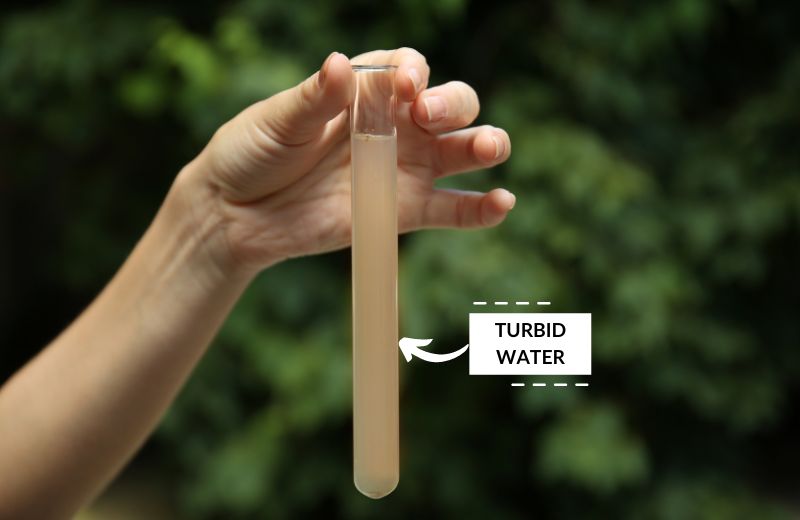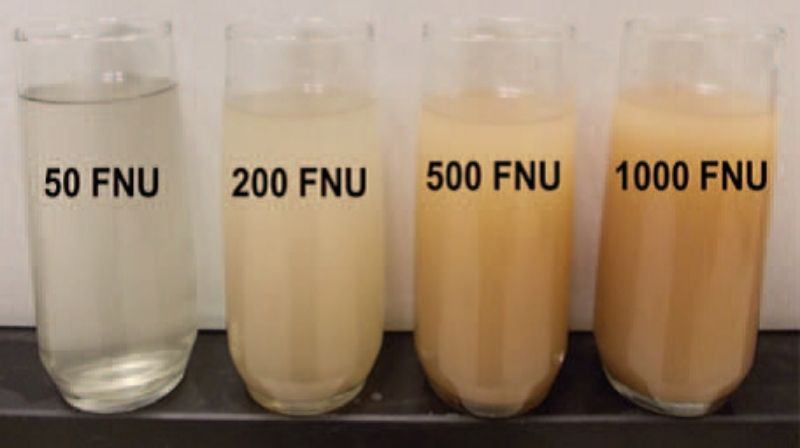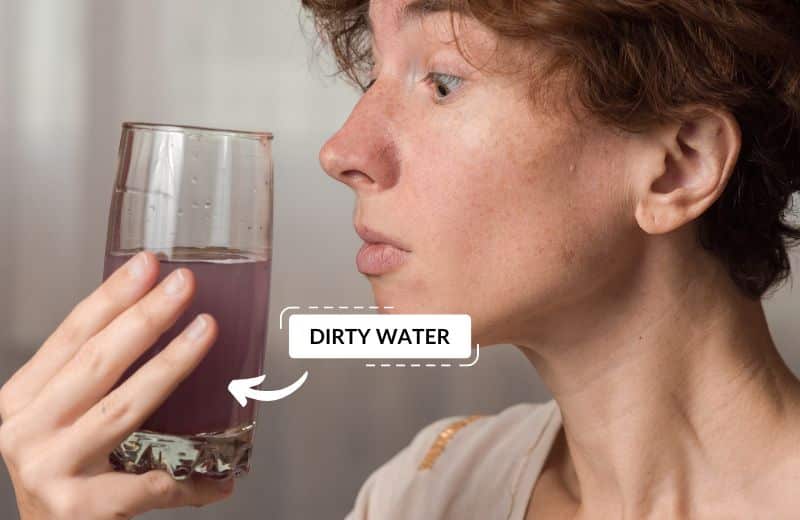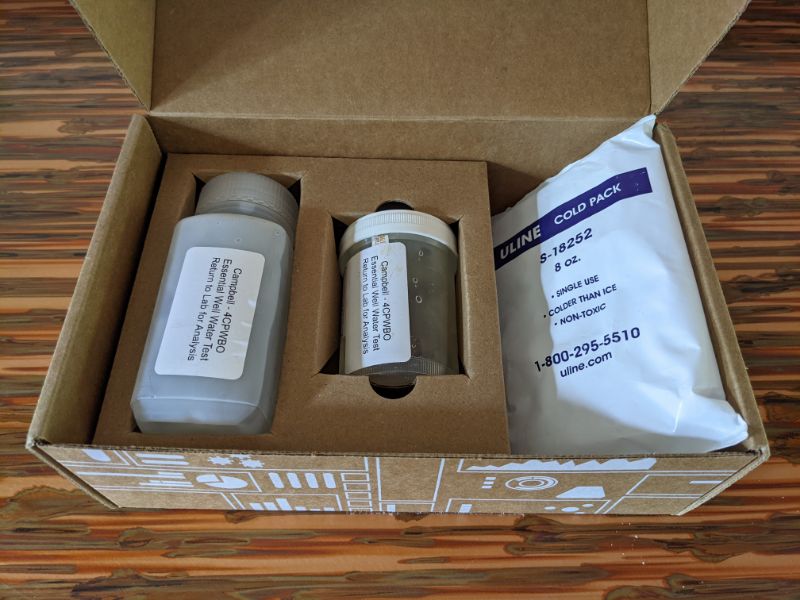Turbidity is one of the common methods of measuring water quality.
If you get a Water Quality Report from your local drinking water utility, you should see “turbidity” listed alongside other chemical and physical water parameters, like pH, temperature, and total dissolved solids (TDS).
In this guide, we’ve answered the question, “What is turbidity in drinking water?”
📌 Key Takeaways:
- Turbidity in water is a measure of a water’s clarity or cloudiness.
- Organic matter, clay, sediment, phytoplankton, algae, and other microscopic organisms all cause turbidity of a water body.
- There are numerous methods of turbidity measurement, including with a secchi disk, turbidity meters, and transparency tubes.
Table of Contents
- 🤔 What Is Turbidity?
- 🔎 What Causes Turbidity?
- 📐 How Do You Measure Turbidity In Water?
- 🆚 Turbidity vs Total Suspended Solids
- 🚱 What’s Wrong With High Turbidity?
- 📈 What Is The Maximum Allowed Turbidity In Drinking Water?
- 👨🔬 Should You Reduce Turbidity In Water?
- 📉 How To Reduce Water Turbidity
- ❔ What Is Turbidity? FAQs
🤔 What Is Turbidity?
Turbidity is a measure of how much light can pass through a water body. Another way to look at turbidity is a measure of the clarity or cloudiness of a water source.
The more scientific definition of turbidity is water’s “relative clarity” – or the amount of light refracting off the suspended particles in the liquid. When measuring turbidity, higher levels of light refraction indicate a higher level of turbidity.

🔎 What Causes Turbidity?
Turbidity is caused by any materials that have the ability to block a light beam from traveling straight through the water.
There are a number of suspended particles and impurities that can cause turbidity. These include:
- Organic and inorganic matter
- Clay
- Silt
- Sediments from erosion
- Phytoplankton
- Other microscopic organisms
How does turbidity get into water sources? Turbidity may increase naturally over time in a surface water supply. Other ways that turbidity may enter a water supply include from waste discharge, urban stormwater runoff (from impervious surfaces, construction sites, etc.), and soil erosion.
Human activity can influence the concentration of suspended solids in a water supply. Farming activities and the use of phosphorous in wastewater treatment processes may increase turbidity due to increased algae growth in the water body.
The type of water source often determines the source of turbidity. For instance, a shallow pond or lake in a warm climate is most likely to be affected by algae growth, while a fast-flowing river is more likely to be affected by sediment, decomposing organic matter, and other suspended material.
📐 How Do You Measure Turbidity In Water?
Turbidity in water is measured in Nephelometric Turbidity Units (NTU). Some experts measure turbidity in Formazin Nephelometric Units, or FNU.
The best way to take an accurate turbidity reading is with a turbidity sensor or turbidity meter (nephelometer). This turbidity measurement method measures scattered light in the water.
There are other, cheaper methods of measuring turbidity, such as transparency tubes and secchi disks, which are often used in lake and stream monitoring programs.
A laboratory analysis can also be used to measure total suspended solids in water, which are linked to turbidity (see below).
👨🔧 We’ve shared an in-depth guide on how to measure turbidity in water if you’re looking for more information.

🆚 Turbidity vs Total Suspended Solids
Turbidity and total suspended solids (TSS) are similar, but not the same.
Turbidity refers to the concentration of material suspended in a water sample, and how this affects light penetration.
On the other hand, total suspended solids (or suspended particles) are the materials in the water that cause turbidity.
So, turbidity and TSS are linked because the higher the concentration of suspended solids, the more turbid the water.
🚱 What’s Wrong With High Turbidity?
High turbidity has an environmental impact and affects the quality of water that is used for drinking.
In natural water bodies, high turbidity readings may harm aquatic life by raising the water temperature and reducing dissolved oxygen. This could affect the function of fish gills, reduce food supplies, and damage spawning beds. Very turbid water may even kill fish or reduce their growth rate, or make them less tolerant to disease.
The treatment processes for turbid water used for drinking water and food processing are more complex and expensive. Water treatment facilities must work harder to make water with a high turbidity level clean and safe for drinking, compared to water with a low suspended particles count.
Drinking water with low turbidity is usually safe, but excess turbidity could be dangerous for human ingestion, depending on what is causing the turbidity. Algae and bacteria in water could make you sick and increase the risk of waterborne disease outbreaks, while high sediment levels could damage your home’s plumbing system.

📈 What Is The Maximum Allowed Turbidity In Drinking Water?
There is no EPA MCL (Maximum Contaminant Level) for turbidity because turbidity isn’t a single contaminant, and high turbidity levels in one water source could look very different than another.
However, some of the individual solids that are found in turbid water are regulated by the Environmental Protection Agency.
The World Health Organization (WHO) says that the maximum amount of turbidity that should be present in water is 5 NTU, but ideally, turbidity measured in water should be 1 NTU at most.
👨🔬 Should You Reduce Turbidity In Water?
So, should you reduce turbidity in water? There’s actually no straight “yes” or “no” answer to this question.
Whether or not you should reduce turbidity in your water depends on the concentration of the turbidity, the contaminants causing the turbidity, and your own personal tastes.
- Turbidity concentration – If your water turbidity exceeds 5 NTU (nephelometric turbidity units), you should look at methods to reduce turbidity because high levels of turbidity could affect water quality, safety, and taste.
- Contaminants causing the turbidity – Certain sediments in your water might not have a big effect on your water quality, while turbidity caused largely by algae or impurities from waste discharge might be unsafe to drink.
- Your own personal tastes – For health reasons or to improve the taste of your drinking water, you might personally decide to reduce your water’s turbidity concentration even if it isn’t higher than the safe level.
To decide whether or not you should reduce turbidity in your water, test your water to see what you’re dealing with. From there, you can decide on a suitable method of water treatment, if necessary.

📉 How To Reduce Water Turbidity
There are a few different water filtration systems and treatment methods that can be used to reduce turbidity.
In the water treatment plant, coagulation and flocculation is used to encourage suspended particulate matter to clump together, making them easier to remove from water.
For at-home use, there are two popular methods of reducing turbidity:
Both these systems use a membrane filtration process that traps the majority of total dissolved solids, effectively lowering water’s turbidity. However, high turbidity concentrations may foul or damage the membrane.
❔ What Is Turbidity? FAQs
What is the normal range for turbidity in water?
The normal range for turbidity in water is 0.1 to 1 NTU (nephelometric turbidity units). Ideally, municipal water suppliers should aim to reduce turbidity levels to an average of 0.2 or less in treated drinking water, regardless of the initial water source or quality.
Is high turbidity good or bad?
High turbidity in drinking water is bad because it means there’s a high concentration of sediments, algae, phytoplankton, and contaminants from urban runoff, which reduces water’s aesthetic quality and potentially makes it unsafe to drink. Even in natural water sources, high turbidity is considered a bad thing because it could affect aquatic life, recreation, and tourism.
How does turbidity affect water quality?
Turbidity affects water quality because generally, the higher the turbidity levels, the higher the likelihood of poor water quality. That’s because many of the causes of turbidity, such as algae and phytoplankton, influence water quality.
Can you drink high turbidity water?
No, you shouldn’t drink high-turbidity water because certain contributors to turbidity (such as algae and waste discharge) may have health effects. Plus, high concentrations of turbidity often indicate the presence of disease-causing microorganisms, which have definite health effects.
What level of turbidity is safe to drink?
The level of turbidity that’s considered safe to drink is 5 NTU or lower. Ideally, water should contain less than 1 NTU of turbidity for it to be guaranteed safe to drink. If you’re drinking from an unknown water source, test its turbidity first, and avoid cloudy or dirty-looking water.

How do we relate turbidity to dissolved oxygen?
High turbidity in water reduces light penetration, which decreases photosynthesis by aquatic plants and can lead to lower dissolved oxygen levels.